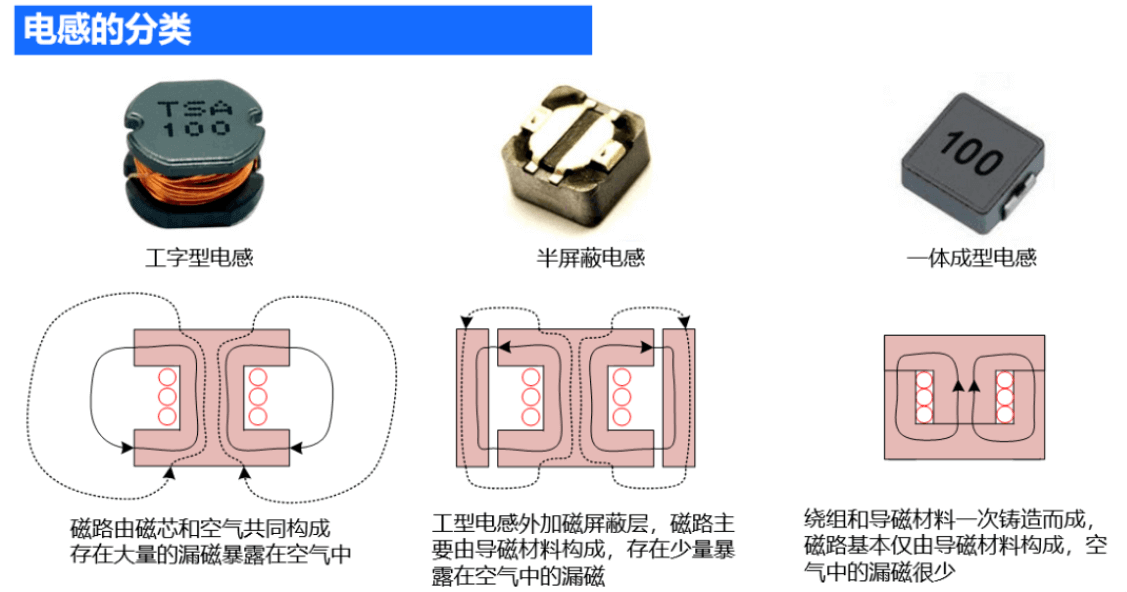Basic Components - Inductors and Ferrite Beads
Inductors
Selection of Inductors
- Size
- Inductance value at the operating frequency
- Inductance value at the switching frequency should match the actual requirement
- Smaller DC resistance (DCR) of the coil is preferred
- Working current should be derated to 0.7 times the rated saturation current, rated rms current
- Smaller AC resistance (ESR) is preferred
- Larger Q factor is preferred
- Shielding type: Shielded or unshielded, shielded type is preferred
- Operating frequency and winding voltage should not be derated
- Brands: TDK, MURATA, Sanritsu, SUMIDA are preferred for surface mount inductors
Key Parameters of Inductors
Inductance (L)
Typical tolerance is 10% or 20% (tested at 1MHz frequency).
Difference in inductance values:
- Small inductance: Low DCR, high saturation current, better dynamic performance, larger ripple current.
- Large inductance: Smaller ripple current.
DC Resistance (DCR)
Can be understood as a parasitic parameter, which is closely related to the package size and inductance value. It is preferable to choose an inductor with smaller DCR during selection.
Relationship between inductance value, size, and DCR:
- For the same inductance value, smaller size results in larger DCR.
- For the same size, larger inductance value results in larger DCR.
- For the same inductance value, a shielded inductor has smaller DCR compared to an unshielded inductor.
Self-Resonant Frequency (SRF)
Due to the presence of parasitic capacitance in the inductor, LC oscillation occurs. Similar to a capacitor, the inductor can exhibit its characteristics only at specific frequencies. As a rule of thumb, SRF is generally 10 times the signal frequency, at which the inductor performs well.
Saturation Current (Isat)
The maximum DC current allowed when the inductance value decreases by 30%.
RMS Current (Irms)
The maximum DC current allowed when the temperature of the inductor rises by 40°C in a 20°C environment.
Generally, the smaller value between Isat and Irms is taken as the rated current of the inductor, and this rated current should be 1.3 times the maximum output current of the circuit, leaving some margin for derating.
Shielding Characteristics

In general, the shielding characteristics are as follows: E-shaped < Semi-shielded < Fully molded.
🚧 Ferrite Beads
Ferrite beads are a type of inductor-based EMI noise filter. They resemble physical inductors, and their equivalent model can be simplified as an inductor and a resistor in series. Ferrite beads are measured in ohms and can suppress noise in the range of several MHz to GHz, often used in signal lines and power lines (in series).
Ferrite beads are measured in ohms (Ω), while inductors are measured in henries (H). Ferrite beads are made of ferrite material, while inductors are composed of a magnetic core and a coil. Ferrite beads convert AC signals into heat energy, while inductors store AC signals and release them slowly. Therefore, inductors store energy, while ferrite beads are energy conversion (consumption) devices.
Ferrite beads are mainly used to solve radiation interference problems and are commonly used on signal lines. Some high-frequency circuits such as RF, oscillation circuits, DDR SDRAM, etc., require ferrite beads to be added to the power input section. Inductors are mainly used to solve conducted interference problems. High-frequency inductors are mainly used in low-frequency filtering circuits, RF matching, while power inductors are mainly used in DC-DC circuits.
Key Parameters of Ferrite Beads
- Impedance (Z): The higher the impedance, the better the noise suppression effect. (Typically tested at 100 MHz)
- DC Resistance (DCR): The resistance exhibited by the ferrite bead when DC current passes through it. Smaller DCR is generally preferred to minimize attenuation of useful signals.
- Rated Current: The maximum current allowed for normal operation of the ferrite bead.
References and Acknowledgements
- How to select inductors?
- "100,000 Whys About Hardware - Passive Components"
- 6 Questions about Ferrite Beads, Can You Answer Them?
Original: https://wiki-power.com/
This post is protected by CC BY-NC-SA 4.0 agreement, should be reproduced with attribution.This post is translated using ChatGPT, please feedback if any omissions.